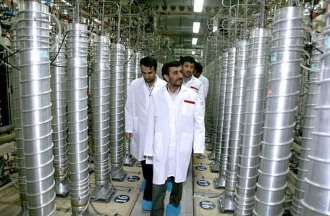The last 48 hours have brought us the announcement of a third party enrichment deal for Iran as well as a US claim that a deal is now in place for new sanctions against Iran. But how big is this uranium stockpile we’re constantly hearing about, and what is “breakout capability” the war party is always harping about?
 According to the IAEA’s February report, Iran’s uranium stockpile at the time consisted of 2,065 kg of 3.6% enriched UF6 (uranium hexafluoride). Given current enrichment rates at Natanz Iran would likely have roughly 2,500 kg at this point.
According to the IAEA’s February report, Iran’s uranium stockpile at the time consisted of 2,065 kg of 3.6% enriched UF6 (uranium hexafluoride). Given current enrichment rates at Natanz Iran would likely have roughly 2,500 kg at this point.
The 3.6% enriched UF6 is being produced by Iran for use in the Bushehr nuclear power plant, which has a VVER-1000/446 reactor from Russia. The initial intention was to have Russia supply the fuel for this reactor, but several rounds of increasingly onerous sanctions have Iran convinced they need to have a domestic source of fuel in case a future round cuts it off.
2,500 kg sounds like a lot, but it is the product of years of Iranian enrichment. 2,500 kg of UF6 is also only about 1,690 kg of actual 3.6% enriched uranium, the rest is simply fluorine.
But 3.6% enriched uranium is only really useful for power generation. The eternal bogeyman of an Iranian uranium weapon would require greater than 90% enriched uranium. Estimates vary on how much is actually needed but 21.6 kg of 235U is a popular number thrown about.
2,500 kg versus 21.6 kg sounds scary, but it actually isn’t. Besides over 800 kg of fluorine, that 2,500 kg of UF6 consists largely of 238U, useful for things like glassware, but of no value in the grand scheme of things nuclear.
So how much 235U are we actually talking about? A rough calculation would be 55 kg, mean that if Iran were to kick out the IAEA and if they were able to reconfigure all their centrifuges and if they were able to convert their entire stockpile of uranium into weapons grade uranium (any of which would set off enormous red flags for the international community), they could have enough weapons grade uranium in a couple of years to attempt to produce two primitive nuclear weapons.
One of those two weapons would be used as a test explosion. These are, after all, of no value if you don’t know they are going to work and if the world doesn’t know you have a working one. This is the “breakout” capability, the possibility that if everything went their way and if the international community just sat on its hands after Iran kicked out the IAEA, withdrew from the NPT, and basically told the world it was making weapons, they could have an arsenal of one functional, post-test weapon.
But check this out, the third party enrichment deal would have Iran send 1,200 kg of that UF6 we’ve been talking about to Turkey, where it would be (eventually) swapped for fuel for a medical isotope reactor.
If this were to happen, which assumes the US didn’t destroy this possibility with Hillary Clinton’s sanctions announcement, this would leave Iran with a stockpile of 1,300 kg of UF6 or about 879 kg of 3.6% enriched uranium, or about 31.6 kg of 235U. Enough perhaps for the test explosion (after all the ifs mentioned above), but nothing else, ergo no breakout capability.
This was the whole point, from the perspective of the P5+1, for the third party enrichment deal in the first place, and it is as true today as it was in October. Why, then, has the US so angrily rejected the deal today after months of demanding Iran agree to it?
Chalk it up to posturing, stupidity, or a pretext for war if you like, but the official answer for the war party will doubtless be that Iran is still producing the UF6 and even while the deal delays the “breakout capability” it is only a matter of time before Iran replaces what it traded and the West is in the same exact position, except that Iranian cancer patients are getting access to nuclear medicine. That can’t be allowed, right?
The simple solution though is sitting on the Persian Gulf in the form of that Russian reactor. Iran doesn’t just want a civilian nuclear energy program, it desperately needs one with the nation’s rising energy demands. Instead of constantly trying to sabotage these power plants diplomatically, the Western nations should be encouraging Russia to get Bushehr up and running ASAP, and should be encouraging Iran to get to work on those other future power plants Ahmadinejad is always on about.
That is, after all, what this stockpile is for in the first place. If Bushehr was operational Iran would be scrambling to produce fuel for it, not just producing the fuel and leaving it lying in a big pile on the ground.
Starting Bushehr is a game-changer for the war party, however, as it makes a prospective Israeli or US attack target an operational civilian reactor full of nuclear fuel in a densely populated area, a war crime of nearly unprecedented proportion. For those still hoping to escalate this into a war this is something to be avoided at all cost. For those genuinely concerned about Iran’s “breakout capability,” however, it is something to be encouraged. Iran must be encouraged to put its civilian stockpile to civilian use, instead of being forced to keep it as an albatross for diplomatic purposes.


